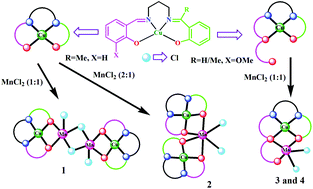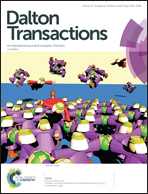Control of nuclearity in heterometallic CuII–MnII complexes derived from asymmetric Schiff bases: structures and magnetic properties†
Abstract
Two new N2O3 donor ligands N-(3-methoxysalicylidene)-N′-(salicylidene)-1,3-propanediamine (H2L2) and N-(3-methoxysalicylidene)-N′-(α-methylsalicylidene)-1,3-propanediamine (H2L3) and their Cu(II) complexes have been synthesized. Using these complexes and another Cu-complex with one asymmetric N2O2 donor ligand N-(α-methylsalicylidene)-N′-(salicylidene)-1,3-propanediamine (H2L1) as metalloligands, four new heterometallic Cu(II)–Mn(II) complexes [(CuL1)2Mn2Cl4]·3CH3OH (1), [(CuL1)2MnCl2]·2CH3CN (2), [CuL2MnCl2]·H2O (3) and [CuL3MnCl2] (4) have been synthesized with MnCl2·4H2O. The tetranuclear (1) and trinuclear (2) complexes were prepared by varying the ratio of the metalloligand [CuL1] and MnCl2 whereas dinuclear complexes 3 and 4 are the sole products irrespective of the metalloligand : MnCl2 ratio. All the complexes 1–4 were structurally characterized by single crystal X-ray diffraction. The tetranuclear (CuII2MnII2) structure of 1 is formed by the dimerization of phenoxido bridged CuIIMnII units whereas the bent CuII2MnII trinuclear species 2 is formed by the coordination of two metalloligands (CuL1) to Mn(II) via a diphenoxido bridge. Complexes 3 and 4 possess a similar dinuclear CuIIMnII structure in which two phenoxido groups form a bridge between the two metal centres. The variable temperature dc magnetic susceptibility measurements reveal that the Cu(II) and Mn(II) ions are antiferromagnetically coupled in all the complexes, 1–4. The values of exchange coupling constants (JMn–Cu) are −45.54, −39.66, −71.54 and −48.40 cm−1 for complexes 1–4, respectively. A DFT study of all the complexes has also been performed to rationalize the experimental results of magnetic measurements.



 Please wait while we load your content...
Please wait while we load your content...